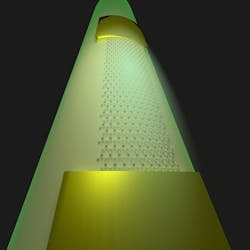Researchers at Rice University (Houston, TX), led by materials scientists Pulickel Ajayan and Jun Lou, have developed a method to make atom-flat sensors, including photosensors, that seamlessly integrate with devices to report on what they perceive.1
Electronically active 2D materials have been the subject of much research since the introduction of graphene in 2004. Even though they are often touted for their strength, they're difficult to transfer to where they're needed without destroying them.
The Ajayan and Lou groups, along with the lab of Rice engineer Jacob Robinson, have a new way to keep the materials and their associated circuitry, including electrodes, intact as they're moved to curved or other smooth surfaces.
The Rice team tested the concept by making a 10-nm-thick indium selenide (InSe) photodetector with gold electrodes and placing it onto the side of an optical fiber. Because it was so close, the near-field sensor coupled with the evanescent field of the fiber and accurately detected the flow of information inside.
The benefit is that these sensors can now be imbedded into such fibers where they can monitor performance without adding weight or hindering the signal flow.
"This paper proposes several interesting possibilities for applying 2D devices in real applications," Lou says. "For example, optical fibers at the bottom of the ocean are thousands of miles long, and if there's a problem, it’s hard to know where it occurred. If you have these sensors at different locations, you can sense the damage to the fiber."
Lou notes that labs have gotten good at transferring the growing roster of 2D materials from one surface to another, but the addition of electrodes and other components complicates the process. "Think about a transistor," he says. "It has source, drain, and gate electrodes and a dielectric on top, and all of these have to be transferred intact. That's a very big challenge, because all of those materials are different."
Raw 2D materials are often moved with a layer of polymethyl methacrylate (PMMA) on top, and the Rice researchers make use of that technique. But they needed a robust bottom layer that would not only keep the circuit intact during the move but could also be removed before attaching the device to its target. (The PMMA is also removed when the circuit reaches its destination.)
The ideal solution was polydimethylglutarimide (PMGI), which can be used as a device fabrication platform and easily etched away before transfer to the target. "We've spent quite some time to develop this sacrificial layer," Lou says. PMGI appears to work for any 2D material, as the researchers experimented successfully with molybdenum diselenide and other materials as well.
The Rice labs have only developed passive sensors so far, but the researchers believe their technique will make active sensors or devices possible for telecommunication, biosensing, plasmonics, and other applications.
Source: http://news.rice.edu/2018/12/06/form-fitting-nanoscale-sensors-now-make-sense-2/
REFERENCE:
1. Zehua Jin et al., ACS Nano (2018); https://doi.org/10.1021/acsnano.8b07159.

